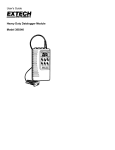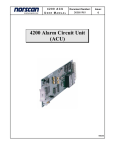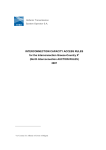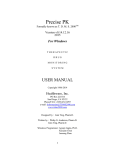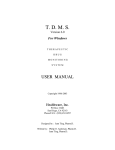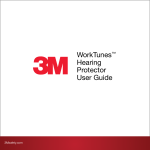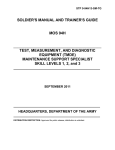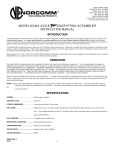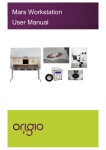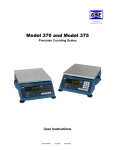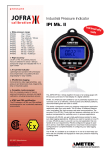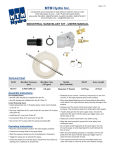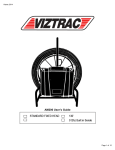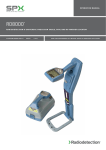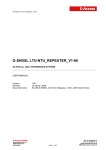Download 4200 MTM practice - Norscan Instruments Ltd.
Transcript
4200 MTM USER MANUAL Document Number: D00802R01 Issue: 3 4200 Multi Tone Module (MTM) 99058 4200 MTM USER MANUAL Document Number: D00802R01 Issue: 3 TABLE OF CONTENTS 1. INTRODUCTION..............................................................................................................................................1 1.1 1.2 2. THEORY OF OPERATION.............................................................................................................................2 2.1 2.2 3. INSTALLATION AT THE CENTRAL OFFICE ....................................................................................................4 INSTALLATION AT A SPLICE ENCLOSURE .....................................................................................................4 INSTALLATION AT THE TERMINATION .........................................................................................................6 CONFIGURING THE MULTI TONE MODULE .........................................................................................9 4.1 4.2 5. CABLE LOCATING USING THE MULTI TONE MODULE ..................................................................................2 LINE TERMINATION UNITS (LTU) ...............................................................................................................2 INSTALLATION ...............................................................................................................................................4 3.1 3.2 3.3 4. STANDARD FEATURES .................................................................................................................................1 SPECIFICATIONS ..........................................................................................................................................1 TONE FREQUENCY PRESETS ........................................................................................................................9 SELECTING TONE FREQUENCY ..................................................................................................................11 MULTI TONE MODULE OPERATION......................................................................................................16 5.1 5.2 5.3 TONE LOCATING OPERATION ....................................................................................................................13 KEYPAD TONE CONTROL ..........................................................................................................................16 MTM CONFIGURATION USING IVR ..........................................................................................................17 CONTACT INFORMATION ..................................................................................................................................20 06/2010 Page: i 4200 MTM USER MANUAL Document Number: D00802R01 Issue: 3 List of Figures: Figure 1: Typical Application - Single Armor Fiber Cable ................................................................... 2 Figure 2: Installation “Zones” .............................................................................................................. 4 Figure 3: Installation at Splice Enclosure With 2745 SGU ................................................................... 5 Figure 4: Installation at Splice Enclosure (Tone locating only)............................................................ 5 Figure 5: Termination Protection Assembly at Building Entry ............................................................. 7 Figure 6: Termination Installation in Splice Enclosure with LTU ........................................................ 8 Figure 7: 4200 CMS Main Menu ........................................................................................................... 9 Figure 8: Frequency Config Menu....................................................................................................... 10 Figure 9: Tone Selection Menu ............................................................................................................ 10 Figure 10: Custom Tone....................................................................................................................... 10 Figure 11: 4200 CMS Main Menu ....................................................................................................... 11 Figure 12: Line Control Menu ............................................................................................................. 12 Figure 13: Configure Line Menu ......................................................................................................... 12 Figure 14: Configure Line Menu with armor monitoring.................................................................... 12 Figure 15: Tone Configuration Menu .................................................................................................. 12 Figure 16: 4200 CMS Main Menu ....................................................................................................... 13 Figure 17: Line Control Menu ............................................................................................................. 14 Figure 18: Line Control Menu for OSP Line With Locating Tone ...................................................... 14 Figure 19: Tone Control Menu ............................................................................................................ 16 Figure 20: Tone Frequency Menu........................................................................................................ 16 Figure 21: Line Menu........................................................................................................................... 16 Figure 22: Line Status Screen With Tone Applied ............................................................................... 17 Figure 23: IVR Menu System ............................................................................................................... 18 Figure 24: Tone Frequency Customizing Menu System....................................................................... 19 Figure 25: Line Description Customizing Menu System...................................................................... 19 06/2010 Page: ii 4200 MTM USER MANUAL 1. Document Number: D00802R01 Issue: 3 Introduction The 4200 Multi Tone Module (MTM) is a full-featured tone generating system. It can provide a wide range of tone frequencies to continuous outside plant cable installations, when below grade cable locating is required. The 4200 MTM module is designed for use in offices where tone cable locating capabilities for one to four cable routes of up to 60 miles or 100 kilometers each is required (actual distances can vary depending on cable armor/sheath condition). Operating over any metallic circuit such as metal armor, trace wire or twisted copper pair the 4200 MTM module will generate frequencies to match your hand held receiver units. 1.1 Standard Features • Can generate user specified frequencies 5 Hz to 10k Hz on North American version. • Can generate user specified frequencies 5 Hz to 1k Hz on UK and European version. • Easy access front control panel for MTM operation 1.2 Specifications Multi Tone Module (MTM) North American version Freq. Range Max. power out Max. voltage out Short cct. Dur. 5 Hz to 10k Hz 50 W 100 V rms Indefinite Multi Tone Module (MTM) UK and European version Freq. Range Max. power out Max. voltage out Short cct. Dur. 06/2010 5 to 1000 Hz 40 W 50 V rms Indefinite Page: 1 of 20 4200 MTM USER MANUAL 2. Document Number: D00802R01 Issue: 3 Theory of Operation 2.1 Cable locating using the Multi Tone Module The Multi Tone Module (MTM) adds cable-locating functionality to the 4200 CMS. Located in the 4200 CMS chassis as an option module, it provides long distance cable toning for locating buried and underground cables. The tone-tracing signal can be activated by a front panel keypad on the 4200 CMS, by telephone using touch-tone commands or by computer using dial up modem access with terminal communication software such as Norcomm™ or Telnet with Telnet software such as Tera Term. The user can select any one of the four cable line outputs and pre-program up to four tone frequencies. Continuous ranges of frequencies are available from 5 Hz to 10k Hz (North American version) or 5 Hz to 1000 Hz (UK & European version). This allows the use of a variety of portable receivers from various manufacturers. The projected range for the tone signal before serious signal attenuation is approximately 60 miles or 100 kilometers on a continuous cable that is terminated with a Line Termination Unit (LTU) (Figure 1). Actual distances will vary depending on cable armor/sheath condition. Note: Only one frequency can be activated simultaneously on more than one line. 42 00 CMS Te r m i na l 42 00 C MS LTU MTM Tone GN D Ar m o r or Sh ie ld Figure 1: Typical Application - Single Armor Fiber Cable 2.2 Line Termination Units (LTU) LTUs provide the required termination impedance for cable locator tones. There are two types of LTUs that can be installed at the termination points along with the monitoring termination sensor(s). 2316 – 0K LTU: This type is used to terminate a single ended cable network topology with no branches. They are designed to draw the tone frequency down the single ended armored line to achieve optimum signal strength at the termination end. 06/2010 Page: 2 of 20 4200 MTM USER MANUAL Document Number: D00802R01 Issue: 3 Note: If the single ended network is less than 20 miles or 32 kilometers from the transmitter source, installing a 2316 – FC LTU is recommended. This will stop the tone frequency transmitter from going into an overload state because of the low load line impedance of the short cable line. 2316 – FC LTU: This type is used to terminate each branch of a multiple branch cable network topology. They are designed to dissipate the tone frequency as evenly as possible throughout the entire branch network and to each termination point. 06/2010 Page: 3 of 20 4200 MTM USER MANUAL 3. Document Number: D00802R01 Issue: 3 Installation The following instructions will explain the installation of a 4200 system that is used for tone locating only. If armor monitoring is being used, refer to the 4200 Alarm Circuit Unit (ACU) user manual for installation and connection details. Installation of the tone locating equipment takes place in three “zones”. The transmitter site, splice points, and the termination site (Figure 2). CO / Gateway / ILA Office Equipment 4200 CMS Splice Enclosure 4200 CMS CABLE MANAGEMENT SYSTEM CO / Gateway / ILA LTU Termination Splice Tray LTU Cable Armor Figure 2: Installation “Zones” Warning! Potential for electrical shock exists when handling cables while the Alarm Circuit Unit (ACU) card is activated or the Multi Tone Module (MTM) is transmitting tone frequencies. Make sure that the ACU card is set to OFF and that the MTM is not transmitting tone on the cable that is being handling at that particular time. Always take DC and AC measurements using a Norscan 1303 System Test Set or a Multi-meter to determine what AC or DC voltages are present before handling the cable. Note: Induced AC and transient voltages can also be present on the cable armor. Temporarily hard ground the cable armor before handling the cable in the central office, outside plant splice or remote termination location. Once the work is completed, remove the hard ground connection to the cable armor. Remove the cable armor connection first and then the local ground connection. 3.1 Installation at the Central Office The Multi Tone Module will come preinstalled and calibrated in a 4200 CMS chassis. The 4200 CMS with an MTM needs to be installed at the central office to transmit the tone signal. For CMS installation details please refer to the 4200 Cable Management System (CMS) with AUIC user manual. 3.2 06/2010 Installation at a Splice Enclosure Page: 4 of 20 4200 MTM USER MANUAL Document Number: D00802R01 Issue: 3 For tone locating the cable must be continuous from the 4200 CMS (transmitter) to the termination. At every splice enclosure the armors in both directions must be bonded together and disconnected from ground. There are two ways of connecting the armors at each splice enclosure. The preferred method of setting up the outside plant for armor monitoring is to install a 2745 SGU at each splice location. The Norscan 2745 SGU provides a path to ground for high voltage transients, and gives the ability to sectionalize the armor without having to enter the splice enclosure. The 2745 SGU is typically placed outside the manhole or cable vault for easy access. With the 2745 SGU the armors in two directions are connected to the SGU via 6-gauge solid wire and bonded together inside the unit (Figure 3). A failsafe gas tube provides high voltage protection for personnel, equipment and the cable itself. Splice Enclosure West / South Armor East / North Armor 2745 SGU Quick Disconnects Figure 3: Installation at Splice Enclosure With 2745 SGU The cable armors can also be isolated from ground and simply bonded together with a wire strap (Figure 4). Splice Enclosure West / South Armor East / North Armor Splice Tray Figure 4: Installation at Splice Enclosure (Tone locating only) For information on armor monitoring connections in a splice enclosure see the 4200 Alarm Circuit Unit (ACU) user manual. 06/2010 Page: 5 of 20 4200 MTM USER MANUAL 3.3 Document Number: D00802R01 Issue: 3 Installation at the Termination Installing a Termination Protection Assembly that includes an Induced Voltage Filter (IVF), Line Termination Unit (LTU) and optional termination sensor is recommended at the Cable Vault or Building Entry Location. The LTUs are used to provide a return ground path for a tone-generated signal from the MTM module. The termination sensors are used to terminate the armor monitoring. The termination sensors have gas tubes embedded in their circuitry, so along with the IVF units, prevent the potential for stray voltage surges or induced AC voltages from causing serious harm to personnel, equipment, or the cable itself. The Termination Protection Assembly is mounted to the wall surface in close proximity to the cable vault area. Connect the cable armors from the outside plant to the appropriate connection terminals (East/North, West/South) as they are labeled on the front cover of the double ended unit assembly. Ground the entire Transmitter Protection Assembly by connecting the Ground/Earth terminal to Building Ground. See Figure 5. 06/2010 Page: 6 of 20 4200 MTM USER MANUAL Document Number: D00802R01 Issue: 3 Note: STU termination sensors are only required if cable armor monitoring is utilized. The 51300 is available for single ended armor terminations (one IVF, STU and LTU). Model 51300 - TERMINATION PROTECTION ASSEMBLY 2303 IVF (60 Hz) or 2313 IVF (50 Hz) EAST/NORTH ARMOR GROUND/ EARTH 2316 LTU FC or 0K BLUE 2230 STU WHITE WHITE 2230 STU 2316 LTU FC or 0K BLUE 2303 IVF (60 Hz) or 2313 IVF (50 Hz) WEST/SOUTH ARMOR Label P/N 50130 Figure 5: Termination Protection Assembly at Building Entry 06/2010 Page: 7 of 20 4200 MTM USER MANUAL Document Number: D00802R01 Issue: 3 If the cable or cable branch terminates inside a splice enclosure, the termination equipment must be installed at the splice where the cable ends. The following diagram illustrates the proper way of connecting a Line Termination Unit (LTU) used in conjunction with the MTM and a termination sensor for armor monitoring in a splice enclosure (Figure 6). Below grade LTUs are also available for installation outside the splice enclosure. Note: The termination sensor is only required if armor monitoring is being used. Proper placement of the LTU and STU devices are essential when installed in a splice enclosure, make sure that these devices are not installed on the fiber tray(s) directly. Splice Enclosure LTU Armor being terminated 22ga MDT Leads Blue STU White Moisture Detection Tape (MDT) Figure 6: Termination Installation in Splice Enclosure with LTU 06/2010 Page: 8 of 20 4200 MTM USER MANUAL 4. Document Number: D00802R01 Issue: 3 Operating the Multi Tone Module This section will explain the configuration and operation of a 4200 MTM with an AUIC. If armor monitoring is being used, refer to the 4200 Alarm Circuit Unit (ACU) user manual for armor monitoring configuration details. Connect to the 4200 CMS via serial, modem or Telnet connection and login using administrator or diagnostic access. For connection and login details see the 4200 Cable Management System (CMS) with AUIC user manual. 4.1 Tone Frequency Presets The Tone Frequency Configuration Menu allows the user to set four standard locating tone frequencies (Administrator or Diagnostic login only). Each of the tones can be configured for a specific frequency to match your hand held receiver(s). The MTM module can also be pre-programmed to generate a Dual Sine Waveform for fault locating with an A-Frame device. To configure the Multi Tone Module use the arrow keys to select Tone Frequency Configuration from the 4200 CMS main menu (Figure 7) and press enter. Note: Menu options will vary based on user access level and card types installed in the 4200 CMS. Line Line Line Line Line Line 1. 2. 3. 4. 11 12 Main Menu <no description> - no cards connected <no description> - no cards connected <no description> - no cards connected <no description> - no cards connected Slot 6 Ch 1. <no description> - FODARK Slot 6 Ch 2. <no description> - FODARK System Configuration Comms Configuration Date/Time Configuration -> Tone Frequency Configuration Alarm Target Configuration Diagnostics Quit Figure 7: 4200 CMS Main Menu The Frequency Config Menu will appear showing the four preset locating tone frequencies (Figure 8). 06/2010 Page: 9 of 20 4200 MTM USER MANUAL Document Number: D00802R01 Issue: 3 Frequency Config Menu -> 1. 577Hz 2. 512Hz 3. 9820Hz 4. 10/20Hz Back Figure 8: Frequency Config Menu To make a change to one of the four preset tones, use the arrow keys to select the tone preset and press enter. The Tone Selection Menu will appear (Figure 9). Tone Selection Menu -> 273 Hz 340 Hz 400 Hz 440 Hz 460 Hz 512 Hz 560 Hz 577 Hz 982 Hz 10 Hz (dual sine) Custom… Back Figure 9: Tone Selection Menu Use the arrow keys to select a preprogrammed tone or select Custom to program a custom tone and press enter. If custom is selected, the Custom Tone dialog box will appear (Figure 10). Custom Tone 1. Tone Description 2. Tone Frequency 3. Tone Type <OK> ____________ 0_____ sine___ <CANCEL> Enter Custom Tone Parameters Figure 10: Custom Tone The Custom Tone dialog box allows the user to specify the tone description, frequency and type of tone. Use the arrow keys to select the menu items. Tone Description: Enter the description for the custom tone and press enter. The description will be used to identify the tone on the AUIC menus. Tone Frequency: Enter the frequency of the custom tone (5Hz – 10000Hz for North America or 5Hz – 1000Hz for Europe) and press enter. The frequency of the tone produced by the MTM inside the 4200 CMS must match the frequency of the tone detected by the locating receiver. 06/2010 Page: 10 of 20 4200 MTM USER MANUAL Document Number: D00802R01 Issue: 3 Note: Refer to receiver operating manual for specific locating frequencies. Tone Type: Press enter to change the tone type then use the up and down arrows to select the type of signal for the custom tone and press enter. The following tone types are available: 4.2 • Sine: Transmits a sinusoidal signal for locating (default). • Square: Transmits a square wave signal for locating. • Fault Locate: Transmits a dual frequency sine wave signal for fault locating with an A-frame fault locator. To configure a fault locate tone, enter the base frequency between 5 and 500Hz and the MTM will generate the second frequency two times the base frequency. For example if the entered base frequency is 10 Hz the dual sine wave signal will be 10/20Hz. Selecting Tone Frequency After the tone locating presets have been set to the required locate frequencies (see section 4.1), the tone locating frequency can be selected. A user who has logged onto the system with operator, administrator or diagnostic access can select a tone locating frequency. Tone locating is available on any of the four outside plant (OSP) lines. To apply a tone to an OSP line, use the arrow keys to select an OSP line (1-4) from the main menu and press enter (Figure 11). Note: Menu options will vary based on user access level and card types installed in the 4200 CMS. -> Line Line Line Line Line Line 1. 2. 3. 4. 11 12 Main Menu <no description> - no cards connected <no description> - no cards connected <no description> - no cards connected <no description> - no cards connected Slot 6 Ch 1. <no description> - FODARK Slot 6 Ch 2. <no description> - FODARK System Configuration Comms Configuration Date/Time Configuration Tone Frequency Configuration Alarm Target Configuration Diagnostics Quit Figure 11: 4200 CMS Main Menu The Line Control Menu for the selected line will appear (Figure 12). Use the arrow keys to select Configure line and press enter to display the Configure Line Menu. 06/2010 Page: 11 of 20 4200 MTM USER MANUAL Line 1: Sensor Armor Tone Document Number: D00802R01 Issue: 3 Line Control Menu <no description> :STU no alarms :ON –0.00mA >150kR no alarms :OFF Deactivate armor monitoring Reset alarms Perform termination test View test results Activate tone (577Hz) Activate tone safety lock -> Configure line... Back Figure 12: Line Control Menu If the armor monitoring service has not been activated on the current line the Tone Configuration Menu items will appear in the Configure Line Menu (Figure 13). Configure Line Menu -> Select tone frequency <577Hz> Change tone auto-shutoff period <10 hours> Add a service... Remove a service... Change line description Back Figure 13: Configure Line Menu If the armor monitoring service has been activated on the current line, the Configure Line Menu will have a “Configure tone locating” option (Figure 14). Configure Line Menu Configure armor monitoring... -> Configure tone locating... Add a service... Remove a service... Change line description... Back Figure 14: Configure Line Menu with armor monitoring Select the Configure tone locating option and press enter. The Tone Configuration Menu will appear (Figure 15). Tone Configuration Menu ->Select tone frequency <577Hz> Change tone auto-shutoff period <10hours> Back Figure 15: Tone Configuration Menu 06/2010 Page: 12 of 20 4200 MTM USER MANUAL Document Number: D00802R01 Issue: 3 Select tone frequency: Selecting this option displays the four tone frequency presets set in the Tone Frequency Configuration (see section 4.1). Choose the frequency to apply to any of the four OSP lines. The tone module in the 4200 CMS can only generate one tone frequency at a time, if tone is already applied to another OSP line, the frequency applied to that line will change to the newly selected frequency. Change tone auto-shutoff period: Enter the length of time in hours to automatically deactivate the tone after it has been applied. Each time the tone is reapplied, the autoshutoff timer is reset. Default is 10 hours. 4.3 Tone Locating Operation When the tone locating frequency has been selected, the tone can be applied to any number of the four OSP lines. A user who has logged onto the system with operator, administrator or diagnostic access can apply a tone locating signal to any of the OPS lines. Select an OSP line from the main menu (Figure 16) and press enter. Note: Only one frequency can be activated simultaneously on more than one line. -> Line Line Line Line Line Line 1. 2. 3. 4. 11 12 Main Menu <no description> - no cards connected <no description> - no cards connected <no description> - no cards connected <no description> - no cards connected Slot 6 Ch 1. <no description> - FODARK Slot 6 Ch 2. <no description> - FODARK System Configuration Comms Configuration Date/Time Configuration Tone Frequency Configuration Alarm Target Configuration Diagnostics Quit Figure 16: 4200 CMS Main Menu Note: Menu options will vary based on user access level and card types installed in the 4200 CMS. The line control menu for the selected line will appear (Figure 17). 06/2010 Page: 13 of 20 4200 MTM USER MANUAL Line 1: Sensor Armor Tone Document Number: D00802R01 Issue: 3 Line Control Menu <no description> :STU no alarms :ON –0.00mA >150kR no alarms :OFF ->Deactivate armor monitoring Reset alarms Perform termination test View test results Activate tone (577Hz) Activate tone safety lock Configure line... Back Figure 17: Line Control Menu WARNING! Potential for electrical shock exists when handling cables while the Alarm Circuit Unit (ACU) card is activated or the Multi Tone Module (MTM) is transmitting tone frequencies. Make sure that the ACU card is set to OFF and that the MTM is not transmitting tone on the cable that you are handling at that particular time. Always take DC and AC measurements using a Norscan 1303 System Test Set or a Multimeter to determine what AC or DC voltages are present before handling the cable. Induced AC voltages can be present on the cable armor when the cable is installed in close proximity to electrical power lines. Activate tone: Select this item from the menu to apply the locating tone to the current line. A tone with the indicated frequency will be applied to the current OSP line. To change the tone frequency on all lines see section 4.2 Selecting Tone Frequency. When a locating tone is applied to the OSP line, armor monitoring is halted and the current state of the locating tone is shown in the top section of the line control menu (Figure 18). Line Control Menu Line 1: <no description> Tone :ON 577.00Hz 615.45mA 67.35V ->Deactivate tone (577Hz) Activate tone safety lock Configure line... Back Figure 18: Line Control Menu for OSP Line With Locating Tone When cable locating is complete select Deactivate tone and press enter, the locating tone will be deactivated and armor monitoring will resume. Repeat this procedure to apply tone to any or all of the four OSP lines. Applying tone to more than one line will share the tone output power between the multiple lines. For maximum locate signal strength only apply tone to one line at a time. 06/2010 Page: 14 of 20 4200 MTM USER MANUAL Document Number: D00802R01 Issue: 3 Activate tone safety lock: This option will toggle the tone safety lock. When the tone safety lock is activated, the locating tone cannot be applied to any OSP lines. This prevents the tone from being applied remotely while cable maintenance is in progress. 06/2010 Page: 15 of 20 4200 MTM USER MANUAL 5. Document Number: D00802R01 Issue: 3 Keypad and IVR Operation 5.1 Keypad Tone Control The front panel of the 4200 CMS with AUIC can be used to select the OSP line for the tone, the tone frequency, and to activate or deactivate the tone. Press the MENU button on the front panel of the 4200 CMS. The Tone Control Menu will appear (Figure 19). -> 577Hz Lines: 1:Off 2:Off 3:Off 4: Off Turn on Safety Lockout Done Figure 19: Tone Control Menu The first item on the Tone Control Menu shows the selected tone frequency. To change the selected tone frequency, move the arrow to the first item using the arrow keys and press OK. The Tone Frequency menu will appear (Figure 20). Select the required tone frequency and press OK. To go back without changing the tone frequency, scroll down, select Back then press OK. -> 1. 2. 3. 4. 577Hz 512Hz 9280 10/20 Figure 20: Tone Frequency Menu The second item on the Tone Control Menu shows the OSP lines that have tone applied. To add or remove tone from an OSP line, move the arrow to the second item using the arrow keys and press OK. The Line Menu will appear (Figure 21). Select the OSP line to add or remove tone and press OK. An asterisk indicates which OSP lines that have tone applied. When OSP line selection is complete, scroll down, choose Done then press OK. The Tone Control Menu will appear and show which lines have tone applied. -> Line Line * Line Line 1: 2: 3: 4: <no <no <no <no description> description> description> description> Figure 21: Line Menu Repeat this procedure to apply tone to any or all of the four OSP lines. Applying tone to more than one line will share the tone output power between the multiple lines. For maximum locate signal strength only apply tone to one line at a time. 06/2010 Page: 16 of 20 4200 MTM USER MANUAL Document Number: D00802R01 Issue: 3 The third item on the Tone Control Menu will activate the safety lockout. To enable the safety lockout, move the arrow to the third item using the arrow keys and press OK. While the safety lockout is enabled, the tone cannot be turned on. To disable the safety lockout, press Menu. A message will be displayed to confirm that the safety lockout will be disabled. Answer Yes or No then press OK. When the tone configuration is complete, select Done from the Tone Control Menu and press OK. The display will return to the Main AUIC screen. If tone has been applied, the Main AUIC screen will show the status of the MTM (Figure 22). Line 2 : (no description) Tone :ON 512.00Hz 278.45mA 64.28V Figure 22: Line Status Screen With Tone Applied 5.2 MTM Configuration Using IVR Interactive Voice Response (IVR) allows the user to access and manipulate the MTM settings via a touch-tone telephone hand set. The 4200 MTM is preprogrammed with factory default voice prompts but can be customized using the telephone. The flow chart in Figure 23 gives an overview on how to configure the 4200 MTM using IVR. 06/2010 Page: 17 of 20 4200 MTM USER MANUAL Phone 4200 CMS The unit will answer after the first ring. You are prompted to enter a password. Document Number: D00802R01 Issue: 3 Using a touch tone phone, enter the IVR password using the phone keypad. "577Hz tone is ON line 1" The 4200 CMS will then respond with the actual state of the MTM module. Press 1 to select different tone. (Main Menu Option) Select from the Main Menu Options Press 1 for "tone message #1" (e.g Press 1 for 577Hz tone) Press 2 for "tone message #2" (e.g Press 2 for 512Hz tone) Press 3 for "tone message #3" (e.g Press 3 for 9820Hz tone) Select a tone from the Tone Menu. The Main Menu will be replayed Press 4 for "tone message #4" (e.g Press 4 for 10/20 Hz tone) Press 9 to customize a tone See figure 24 for tone customizing details Press * to return to main menu Press 2 to select different line. (Main Menu Option) Press 1 for "line message #1" (e.g Press 1 for North line 1) Press 2 for "line message #2" (e.g Press 2 for South line 2) Press 3 for "line message #3" (e.g Press 3 for East line 3) Select a line from the Line Menu (multiple lines can be selected). The Main Menu will be replayed Press 4 for "line message #4" (e.g Press 4 for West line 4) Press 0 to disconnect all lines Press * to return to main menu Press 3 for Cable Maintenance (Main Menu Option) Press 9 to Customize Descriptions (Main Menu Option) The 4200 MTM will enter maintenance mode, the tone will be turned off and the phone will hang up. To exit maintenance mode, connect to the 4200 CMS and press 1 to deactivate maintenance mode. See figure 25 for description customizing details Press * to disconnect. (Main Menu Option) Figure 23: IVR Menu System 06/2010 Page: 18 of 20 4200 MTM USER MANUAL Document Number: D00802R01 Issue: 3 The user can customize tone-locating frequencies via the IVR menu. The tone frequency customizing menu system is shown in Figure 24. Press 9 for Custom Tone Press the number of the tone you want to customize. Enter the custom tone frequency Press 1 for a standard tone Press 2 for a dual frequency tone Press 9 to re-enter the tone Press * to return to the tone menu Figure 24: Tone Frequency Customizing Menu System The user can also customize the audible line descriptions via the IVR menu. The line description customizing menu is shown in Figure 25. Press 9 to customize descriptions Press the number of the line you want to configure or press 9 to change the system description Record the new description Press 1 to re-record Press 2 hear recording Press 3 to keep original recording Press * to accept new recording Figure 25: Line Description Customizing Menu System 06/2010 Page: 19 of 20 4200 MTM USER MANUAL Document Number: D00802R01 Issue: 3 If you need further assistance please contact Norscan Instruments Ltd. 30 Priarie Way Winnipeg, MB R2J 3J8 CANADA PH: (204) 233-9138 Fax:(204) 233-9188 email: [email protected] web: http://www.norscan.com 06/2010 Page: 20 of 20
























